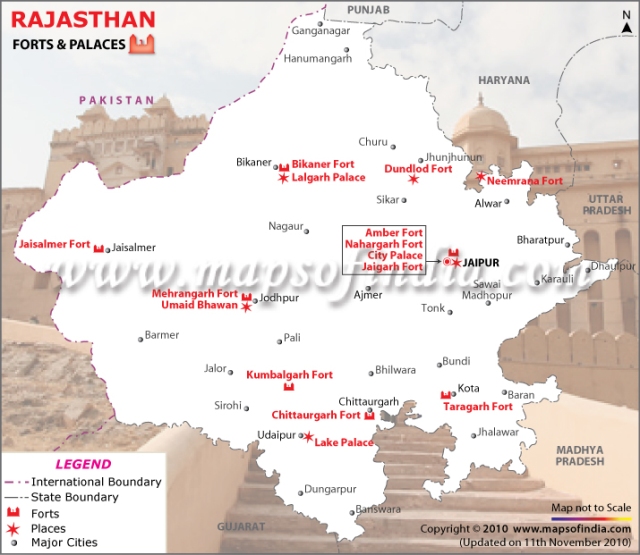
It’s India’s ‘Sun City’ with an interesting legend to it! Legends tell of a hermit who was once turned out from a rocky ridge, so that a mighty fort could be built at the site… so enraged was he, that he cursed the land to be inflicted with drought and famine from that day forth… changing the city into the desert as we know it today, Jodhpur.
One of India’s most romantic destinations, Jodhpur; Rajasthan’s second largest city founded by Rao Jodha is known by many names such as the ‘Gateway to Thar’ as it literally lies on the edge of the Thar desert…‘Blue city’ for its many blue houses around the Mehrangarh Fort, and even ‘Sun City’ for the bright sunshine it gets throughout the year.
A city well known for its majestic forts, beautiful havelis, gardens, rich history & more, travelling to Jodhpur is no problem as the city is well connected to other parts of the country by air/ road and rail.
Dominating the skyline, and literally the centre of the city & attention is the Mehrangarh Fort, not just the biggest attraction of Jodhpur but also the largest fort in Rajasthan. A colossal fort, it occupies the entire hill top spreading over 150 meters; the walls of the fort are of a height of 36 meters while the width is 21 meters. Though the fort was initiated by Rao Jodha in 1459, he did not live to see it in its full glory.
Magnificent not just from the outside but the inside as well, it was home to several palaces, temples and also an exquisite garden. Important structures here include the Sheesh Mahal (Hall of Mirrors), Phool Mahal (Hall of Flowers) that was used by the Maharaja for entertainment and parties, and the Moti Mahal (Pearl Hall) was where the Maharaja allowed his audiences.
The Zenana Deodi was of palaces of his queens/consorts, and the Chamunda Mataji Temple was devoted to the Maharaja’s favorite goddess. Other attractions here include the royal throne of the Maharaja known as Sringar Chowki, the gold filigree work on the mahals, paintings, musical instruments, furniture, palanquins, weapons and attire worn by the Maharajas stored in the Mehrangarh Fort Museum, a museum considered to be one of Rajasthan’s best maintained museums to date.
While the fort has seven gateways, the most famous of them is the Jaya Pol(meaning Gate Of Victory), built by Maharaja Man Singh to celebrate his victory over the armies of Jaipur & Bikaner. Other important gateways include the Fattehpol constructed by Mahraja Amit Singh to commemorate his victory over the Mughals, and the Loha Pol – the most guarded gateway to the palaces of the kings and queens. This gate bears the palm imprints of the many queens and princesses who committed Jawhar (self immolation) for the sake of their consorts.
Though there is no history of the fort being captured, today one can still see impressions left by cannon balls on the walls. Also within the area are the cenotaphs of the brave kings who ruled Jodhour; Jaswant Thoda being the royal cenotaph built in memorial of Maharaja Jaswant Singh, the 33rd king of Jodhpur.
Built by Maharaja Umaid Singh in 1944, the Umaid Bhawan Palace is also known as Chittar Palace because of the local chittar sandstone used in it. Splendid and known for its Indo-Colonial architecture, this palace built by Henry Vaughn, is still the home of Jodhpur’s present day ‘Maharaja’ while a part of it has been converted into a heritage hotel and another portion into a museum where one can find some wonderful antiques, paintings, crafts, crockery, weapons, stuffed animals etc.
One of the biggest temples, the Mahamandir Temple about 2 km from here literally translated to ‘huge temple’ is known for its intricately carved pillars and sculptures. Built in 1812, these beautiful sculptures, and walls decorated with traditional motifs don’t fail to mesmerize tourists visiting it.
About seven km from the city, the Balsamand Lake, an artificial reservoir built in 1159 AD to provide water is today an interesting picnic spot, as it is surrounded by palaces, and gardens which attract many peacocks and other birds thus providing a picturesque setting for those visiting this lake. Another scenic lake here is the Takhat Sagar Lake about 10 km from the city, while the Mandore Gardens that contains cenotaphs of the former Marwar Kings is noted for their beauty. Amidst the rock terraces, these beautiful four storey red sandstone monuments along with the ruins of a fort and a palace capture the hearts to all those visiting these gardens, while Guda, is a wonderful place for tourists to enjoy the exotic wildlife of the region.
At 85 km from the city, the Khejarla Fort, a 400 year old fort built of red sandstone is another interesting attraction with its fine architecture, picturesque views, intricate Jharoka and other fine works.
Last but not the least, Jodhpur is incomplete without a mention of the shopping one can enjoy here. A shopper’s paradise… look out for the lehengas, bandhini fabrics, ethnic clothes, exquisite handicrafts, mojiris or traditional Jodhpuri shoes that are available here!!
While handicrafts from here are famous across the country, Jodhpur is especially known for its furniture that is made of quality wood that doesn’t go out of fashion. Not only are these exquisite pieces in high demand across India but also other parts of the world.
And don’t forget those chillies for Jodhpur is also home to some of the best chilli powders that come from the Mathaniya region.
One of Rajasthan’s most beautiful destinations, Jodhpur is a destination that is known for its heritage, history, culture and rich architectural wonders, one that will have you wanting to return for more!







